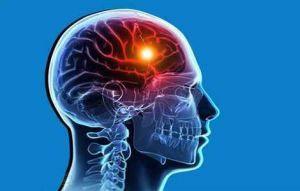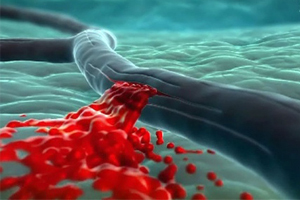Subarachnoid hemorrhage (SAH) - a pathology which is accompanied by the accumulation of blood in the space between the lining of the brain: the arachnoid and soft. This disease is a type of stroke and occurs in 1-10% of cases of acute cerebrovascular events.

Contact with blood in the subarachnoid cavity is accompanied by characteristic neurological symptoms and often leads to death.
Causes
Bleeding in the subarachnoid space is a separate subtype hemorrhagic stroke. Pathogenesis of disorders is to increase the volume of fluid in the gap due to subarachnoid blood streamed from the broken vessel. This leads to a strong irritation pia mater. In response to the loss of blood there is vasoconstriction, which causes ischemia of other parts of the brain and can cause transient ischemic attack or ischemic stroke.
The causes of subarachnoid brain hemorrhage are the following phenomena:
- brain aneurysm. Availability aneurysm (protrusion wall) is larger cerebral vessels CAA etiological factor in 70-85% of cases. The most common cause of hemorrhage is the gap saccular aneurysms. Strokes aneurysmal origin differ by less favorable prognosis than neanevrizmaticheskie spontaneous bleeding.
- Stratification of the great arteries (vertebral, carotid). In most cases, to the ingress of blood into the space between the membranes of the brain leads bundle vertebral artery wall in the cervical region. More rare etiologic factor is the separation of the internal carotid artery. The most common causes of vascular bundles are considered strong by cervical dislocation, whiplash, osteopathic and surgical manipulation.
- Traumatic brain injury. Skull fracture, an open head injury, brain contusion and compression cause damage to major blood vessels of the brain, which leads to spillage of blood between the membranes of the brain. Subtype of this factor is the birth of the newborn injury that can occur when a narrow pelvis mothers, anomalies development and the large size of the fetus, as well as pathologies of pregnancy (intrauterine infection, perenoshennosti, rapid and early childbirth). Traumatic etiology have less than 15% of clinical cases of CAA.
- Other reasons (found less than 5% of cases). These include cerebral and spinal neoplasms, lesions secondary malignant tumors (e.g., myxoma of the heart), vasculitis, amyloidosis angiopathy genesis, composition of blood disorders and hemodynamic (Coagulopathy, sickle cell anemia), Pituitary hemorrhage gap tsirkumferentnoy artery in the brain stem, and others.

Approximately 10% of patients bleeding in the subarachnoid space has unknown etiology. For this disease, which is called neanevrizmaticheskim perimezentsefalicheskim hemorrhage, characterized by the lack of precise source of bleeding, weak expression of symptoms of stroke and favorable forecast. It is assumed that such bleeding may be caused by rupture of the walls of small blood vessels, which leads to the possibility of closing the gap space at the expense of body resources.
In rare instances, bleeding may result from vascular lesions (arteriovenous malformations and fistulas). With this etiology of the disease is observed mainly mixed (subarachnoid and parenchymal) hemorrhage.
Comorbidities main causes of hemorrhage (saccular aneurysm) are the following pathologies:
- genetic disorders that lead to the disruption of the formation of connective tissue, skin and vessels (Ehlers-Danlos syndrome, Grenblada-Strandberg and Marfan's, alpha-antitrypsin deficiency and etc.).;
- genetic predisposition;
- anomalies of the circle of Willis arteries;
- neurofibromatosis;
- polycystic kidney disease;
- dilation of small blood vessels (telangiectasia);
- arterio-venous malformations;
- coarctation of the aorta;
- Moyamoya disease.

Risk factors for the development of SAH are:
- arterial hypertension;
- alcohol abuse;
- receiving drugs (most often - Cocaine and other stimulants);
- atherosclerosis and high concentration of low density lipoproteins in the blood;
- obesity;
- smoking;
- hormone replacement therapy and COCs;
- pregnancy and childbirth.
symptoms
The symptoms of subarachnoid hemorrhage include the following events:
- severe headache (most often - against the background of severe stress or strain);
- pain in the neck (only when the bundle of the vertebral artery in the neck);
- inhibition or loss of consciousness (depending on the volume of blood in the subarachnoid space and location of the lesion, this symptom can range from mild to stun rapid confluence into a coma);
- meningeal syndrome (vomiting, neck tension, hypersensitivity, intolerance to sound and light);
- seizures (10% cases);
- agitation, the predominance of the sympathetic nervous system tone;
- ophthalmic disorders (reduced visual acuity, ophthalmoplegia, bleeding in the eye retina, nystagmus et al.);
- disorders of the respiratory activity (in aneurysms of the lower segment of the cerebral artery).

Character combination, and severity of symptoms depend on the location of the source of bleeding. Features that distinguish BAC from bleeding in the brain, are the nature and time of pain syndrome: when blood enters the subarachnoid period of neurological symptoms develop within a few minutes.
When aneurysmal subarachnoid hemorrhage symptoms of neurological pathology can be observed for several weeks prior to rupture of the weak portion of the vessel. This phenomenon is typical for large aneurysms.
Every third patient with SAH observed atypical pathology for: signs of hemorrhage may resemble the clinical picture of an acute psychosis, inflammation of the meninges, hypertensive crisis, neck and sciatica migraine.
How is diagnosed
Suspect the presence of SAH patient may neurologist from the characteristic clinical picture of disease. However, an accurate diagnosis is not enough information about what is subarachnoid hemorrhage, and how it manifests itself, depending on the location of the lesion. In addition to the external signs, the doctor should have the results of laboratory and hardware research.
The most informative diagnostic methods include:
- CT scan. CT scan of the brain is the most accurate method of investigation for suspected SAH. Imaging reveals brain edema, bleeding into the ventricles and subarachnoid shell pockets ischemia and others. In 1-2 days after stroke sensitivity of the method is greater than 95%, for 2-3 days - 80-85%, and 6 days after hemorrhage - less than 30%. When delayed diagnosis of CAA is more informative method for magnetic resonance imaging of the brain.
- Transcranial ultrasound and duplex scanning of cerebral vessels. Catheter diagnosis of cerebral vascular allows you to set the source of bleeding, diagnose vasospasm and determine the need for an urgent surgical intervention. If the source could not be detected at the first examination, it is recommended repeated ultrasound vessels through 20-28 days after SAH.
- MRI angiography. In the presence of contraindications for endovascular studies of cerebral arteries non-invasive angiography is performed by computer or magnetic resonance imaging. In severe disease research is conducted after stabilization of the patient's condition.
- Needling cerebrospinal fluid (CSF). Characteristic features CAA is reddish or ksantohromny color cerebrospinal fluid, high concentration of red blood cells (more than 100 000 units. / ml), increased levels of protein and leukocytes (Neutrophils). A sample of cerebrospinal fluid is essential in cases when there is no opportunity to CT or tomography shows cerebral changes during the characteristic neurological picture. At high risk of dislocation (displacement) of the brain, this manipulation is prohibited.

therapies
pathology treatment is divided into first aid, conservative therapy, surgery and rehabilitation. All stages of therapy aimed at normalizing the function of the brain, the correction of biochemical parameters and prevention of bleeding complications.
First aid
First aid and treatment of subarachnoid hemorrhage should be performed in a medical hospital. If you experience symptoms of SAH (severe headache, loss of consciousness, etc.) The person who is next to you must immediately call an ambulance and watch the victims before the arrival of doctors to avoid overlapping of the respiratory ways.
The medical team has an emergency patient care for relief of seizures and other symptoms, and then transports it to the intensive care unit or neurological hospital.
medicines
Treatment of subarachnoid hemorrhage involves the use of drugs such as:
- nimodipine;
- epsilon-aminocaproic acid;
- antiplatelet agents;
- antiemetics (Reglan);
- laxatives and diuretics (Mannitol, furosemide);
- anticonvulsants (diazepam, valproic acid);
- correctors cerebral circulation (Cavinton, Aktovegin);
- sedatives (droperidol), and others.

Conservative therapy is intended to correct only the consequences of hemorrhage: reduce swelling brain vasospasm prevention, ischemia, and thrombosis of vessels, as well as relief of symptoms pathology.
During treatment, the obligation to comply with bed rest.
Operation
In the first 3 days after the onset of SAH possible surgical removal of disease. It is carried out by clipping the neck of the aneurysm or filling the vessel by a balloon catheter (endovascular occlusion). Both methods aim to exclude aneurysm site of cerebral blood flow.
The operation may also be to reduce cerebral edema and its prevention dislocation. In these cases, performed ventricular drainage or craniotomy.
rehabilitation procedures
Rehabilitation after subarachnoid hemorrhage brain lasts at least six months. Nootropics are assigned to a patient, circulatory correctors, vitamins, drugs for the maintenance of normal blood pressure and hemodynamics.
For the prevention of recurrence of violations and restore brain functions recommended lifestyle correction (giving up smoking, alcohol, drugs), diet and physical therapy.



